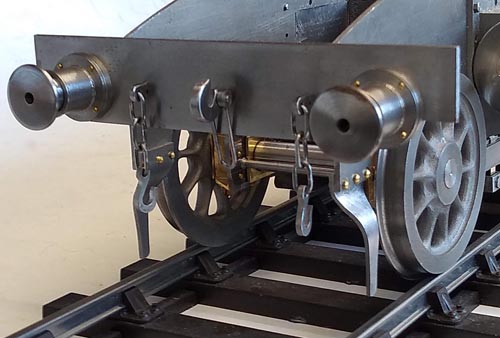Nick Baines • Model Engineering
Assembly
Time now for a decision about the powertrain. The only commercial motor-gearbox units in Gauge 3 are Slater's, and they were out because Slater's decided to adopt a ¼ in diameter axle, which is way too small for most locos and frankly looks quite spindly. Considering that they use 3/16 in for O gauge, and ¼ in for Gauge 1, both of which are close to scale for many prototypes, the logical choice for Gauge 3 would be 3/8 in. I've looked at a lot of loco drawings, and that would be somewhere close for all but tiny (mostly industrial) or very early locos.
Not only does it make the view between the frames look wrong, which admittedly not everyone cares about, but it compromises the wheel hubs and that is very obvious. So why?
The usual powertrain is an electric motor rotating at high speed and a gearbox with a large step down ratio, usually (these days) using a helical gear followed by one or more pairs of spur gears. Okay, I can do that, but do I have to? When I looked, the internet was awash with geared motors of the right sort of size and power rating, with a built-in gearbox providing a final drive of anything between 1 and 1000 rev/min. If I chose the right ratio, a simple bevel gear to connect the motor output shaft to the axle was all that was necessary.
I checked with the G3 forum and no-one seemed to think it was a bad idea, so I ordered up a 60W, 500 rev/min, 37 mm diameter motor. I calculated the speed would be sufficient for a scale 70 mph which is probably as much as the prototype regularly achieved. There is no point in trying to calculate the power (or torque) because there are so many uncertainties - the final weight of the loco, the weight of the train, the gradients and curvatures of the track, and so on - so I judged the rated power on what others seemed to be using.
I used 1:1 bevel gears for the final drive. It took a bit of juggling with CAD to get them in but it all worked out successfully in the end. I had to bore out both gears to fit the motor shaft and the axle, and made sure there was enough meat on the boss to allow for a fixing grub screw even on the axle gear. Here is the result.
Not only does it make the view between the frames look wrong, which admittedly not everyone cares about, but it compromises the wheel hubs and that is very obvious. So why?
The usual powertrain is an electric motor rotating at high speed and a gearbox with a large step down ratio, usually (these days) using a helical gear followed by one or more pairs of spur gears. Okay, I can do that, but do I have to? When I looked, the internet was awash with geared motors of the right sort of size and power rating, with a built-in gearbox providing a final drive of anything between 1 and 1000 rev/min. If I chose the right ratio, a simple bevel gear to connect the motor output shaft to the axle was all that was necessary.
I checked with the G3 forum and no-one seemed to think it was a bad idea, so I ordered up a 60W, 500 rev/min, 37 mm diameter motor. I calculated the speed would be sufficient for a scale 70 mph which is probably as much as the prototype regularly achieved. There is no point in trying to calculate the power (or torque) because there are so many uncertainties - the final weight of the loco, the weight of the train, the gradients and curvatures of the track, and so on - so I judged the rated power on what others seemed to be using.
I used 1:1 bevel gears for the final drive. It took a bit of juggling with CAD to get them in but it all worked out successfully in the end. I had to bore out both gears to fit the motor shaft and the axle, and made sure there was enough meat on the boss to allow for a fixing grub screw even on the axle gear. Here is the result.
Here is the chassis partly assembled, with the wheels and coupling rods in place.
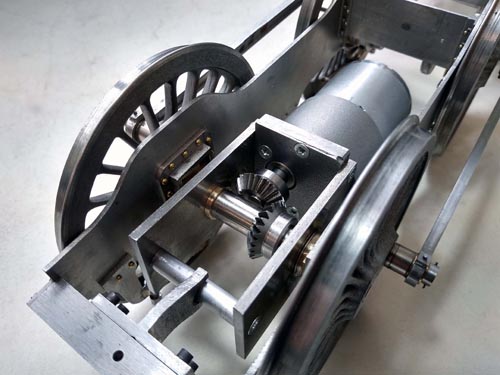
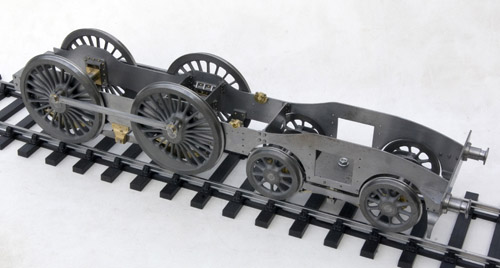
And now the motor-gearbox, cylinders, slidebars and coupling rods. Oops, the coupling rod is upside down. I bet the assembly shop foreman had some choice words for his fitters about that.
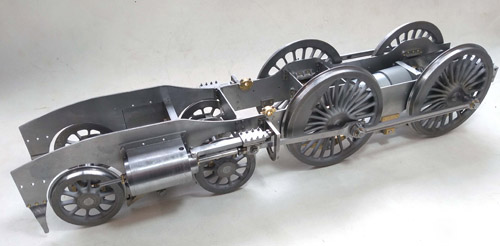
Incidentally, the tail rods are dummies and are removable. The plan is to have them there when the model is on show, but they do restrict the swing of the bogie wheel. Our curves are a lot tighter than scale, so for running, they can come off if necessary.
Now all the valve gear is in place. That completes all of the moving parts, unless I decide to make the reverser work just for the heck of it.
Now all the valve gear is in place. That completes all of the moving parts, unless I decide to make the reverser work just for the heck of it.
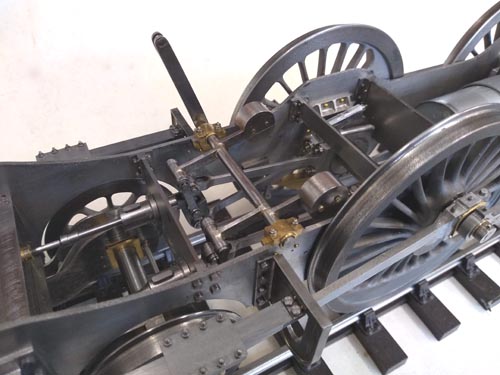
I had the brake shoes and blocks printed in a hard nylon. They are a good candidate for 3DP because they are an awkward shape that would need, I reckoned, at least three setups to machine. As received the surface is a bit rough (the photo makes it look worse than it is) but it is easily filed smooth. I chose nylon for its durability and because it is low friction in case it came into contact with the wheels. Which, when you think about it, is the exact opposite of the needs of the real thing.
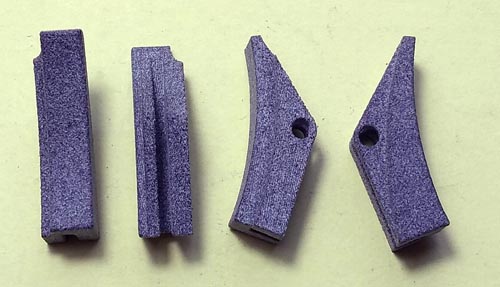
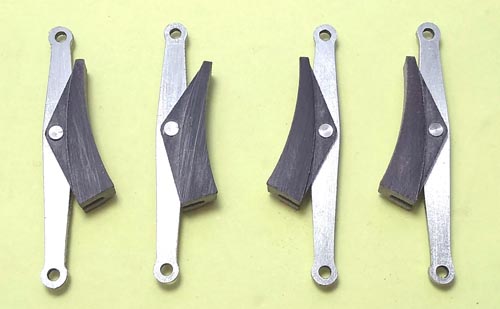
I also tried to get the connectors between the brake bars and the pull rods printed, but they were too fine for the process. (The feedback from the printer suggested that I "scale them up". Evidently they don't get many requests for exact scale components.) I ended up machining them like everything else.
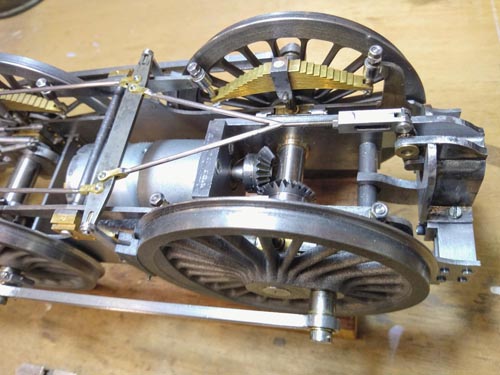
In addition to the brake equipment, all the detail of the front buffer beam is done. The buffer heads are sprung with a coil spring inside the bodies and secured with a bolt that is inserted through the hole in the centre of the face - just like the prototype. I tried to find some commercial chain for the safety chains, but could not find anything of the right size, shape and finish, so ended up making my own. The links are steel wire, thoroughly annealled to soften it, wrapped around a former. After a couple of attempts I got the hang of it.
